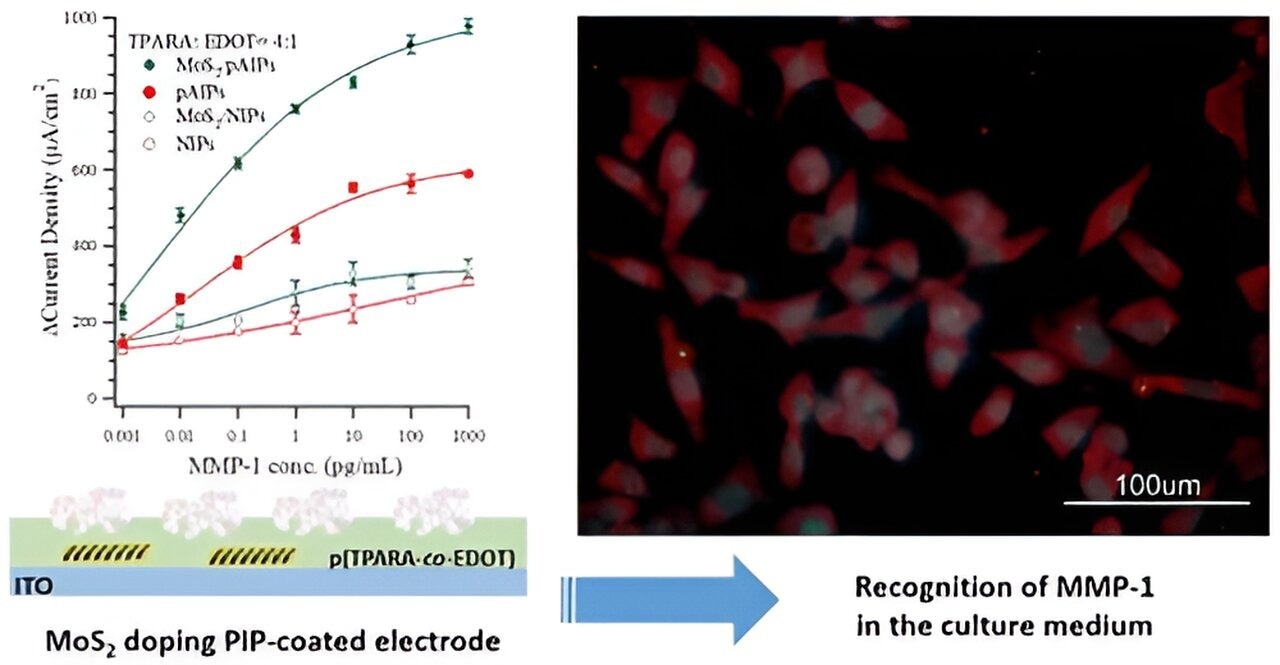Patients who suffer from certain long-term diseases might have to wait years to receive an accurate diagnosis. For instance, numerous pulmonary and cardiovascular problems can present with symptoms similar to shortness of breath. As a result, patients could receive therapy for a disease that is misdiagnosed and far from being appropriately treated.
 Graphical abstract. Image Credit: ACS Applied Nano Materials (2023). DOI: 10.1021/acsanm.3c04130
Graphical abstract. Image Credit: ACS Applied Nano Materials (2023). DOI: 10.1021/acsanm.3c04130
Thus, monitoring the amounts of particular substances in the body as a disease develops is one of the most promising approaches to solving this issue. In this regard, researchers from the National Kaohsiung University in Kaohsiung (Kaohsiung, Taiwan) and the Institute of Physical Chemistry of the Polish Academy of Sciences (Warsaw, Poland) presented their study on creating a rapid and accurate diagnostic tool for a fatal pulmonary disease.
Idiopathic pulmonary fibrosis (IPF) is a chronic disease that leads to lung fibrosis and can be deadly, causing asphyxia. The most typical symptoms are dyspnea and dry cough, which can be linked to several other conditions. As a result, it is frequently misdiagnosed as a variety of ailments, which makes an accurate diagnosis difficult to come by and has a major negative impact on a patient’s quality of life.
Furthermore, symptoms could go undetected until it is too late to save the patient. The pathogenesis of IPF remains unknown. As a result, it is crucial to diagnose IPF early. One approach is the electrochemical detection of IPF biomarkers. Biomarkers are substances, such as proteins, nucleic acids, or other substances, that the body produces improperly when a disease develops. Multiple biomarkers can be identified for IPF.
Matrix metalloproteinase-1 (MMP-1) is one of them; it breaks down fibrillar collagens in the respiratory system. Although MMP-1 has well-known chemical features, it is currently far from a perfect diagnosis when this biomarker is rapidly monitored in bodily fluids as part of the course of IPF.
Scientists from the Department of Chemical and Materials Engineering at National Kaohsiung University in Kaohsiung, Taiwan, and researchers from the Institute of Physical Chemistry of the Polish Academy of Sciences (IPC PAS) in Warsaw, Poland, recently developed a new electrochemical chemosensor for the efficient, quick, and selective determination of the IPF biomarker, specifically MMP-1, with the goal of accelerating IPF and rapid diagnostics.
The scientists used a technique called molecular imprinting in polymers to create this chemosensor. This involves combining a functional monomer, a cross-linking agent, and a template. The result is a polymer matrix that forms molecular cavities in the shape of template molecules, which correspond to molecular keys that fit into polymer locks.
They specifically altered the transparent electrode, which was a glass slide covered in conducting indium-tin oxide, or ITO, by adding poly(TPARA-co-EDOT), a molecularly imprinted polymer (MIP) formed of two monomers, EDOT and TPARA. Furthermore, the MIP was templated using the peptide epitope of the MMP-1 protein biomarker and doped with a MoS2-2D flaky material.
After that, the template was taken out of the MIP, leaving behind molecular holes that matched the size and shape of the peptide epitope molecules that were going to be imprinted. The MIP makes it simple to identify the corresponding molecule since the holes match these distinctive peptide molecules. Interestingly, compared to the undoped MIP, doping the MIP with MoS2 greatly increased the MMP-1 detection limit.
Incorporating novel materials into electrochemical chemosensors can enhance their performance and help elucidate their sensing mechanism. In our research, (peptide epitope)-templated MIP was doped with MoS2 flakes with a mean size of 0.6−1.5 μm during its deposition as a thin film onto an ITO electrode. Essentially, this doping doubled the electrochemical response (above the background) to the target MMP-1 protein biomarker.
Dr. Piyush S. Sharma, Institute of Physical Chemistry, Polish Academy of Sciences
The immune system recognizes several peptides termed epitopes positioned at the borders of the MMP-1 macromolecule. These epitopes have a good application in electrochemical MIP chemosensors as an imprint. As a result of protein imprinting failing to successfully determine them and produce huge holes that could accommodate several smaller-molecule compounds, the imprinted molecules were peptide epitopes, which are substantially smaller than proteins.
Peptides are also more stable than proteins in experimental settings, such as using an organic solvent during the formation of a polymer layer on the electrode surface, in addition to their smaller size. It is important to note that the use of MoS2 flakes facilitates the identification of idiopathic pulmonary fibrosis and the MMP-1 biomarker.
The MoS2-doped pAIPs film-coated electrode performance is comparable to the recent literature. Finally, the electrode was used to determine MMP-1 in the culture media of gene-edited HEK293T cells and, compared to a commercial ELISA assay, its accuracy was high.
Prof. Włodzimierz Kutner, Professor, Institute of Physical Chemistry, Polish Academy of Sciences
The results of this study, which are described in ACS Applied Nano Materials, show potential for tracking the onset and progression of progressive, chronic medical conditions with unclear pathophysiology and etiology, such as idiopathic pulmonary fibrosis.
While testing detection under disruptive conditions remains an option, it is expected that molecular imprinting in polymers will garner more attention and be used in biomedicine to bring society one step closer to speedy and accurate diagnosis of many difficult diseases. The scientists are hopeful that their well-established idea of a molecularly imprinted electrochemical chemosensor may be extended to more diseases and customized treatments.
Journal Reference:
Lee, M.-H., et. al. (2023) MoS2 Nanosheet-Doped Peptide-Imprinted Polymer-Coated Electrodes for Electrochemical Determination of CRISPR/dCas9-Activated Protein Expression. ACS Applied Nano Materials. doi:10.1021/acsanm.3c04130.